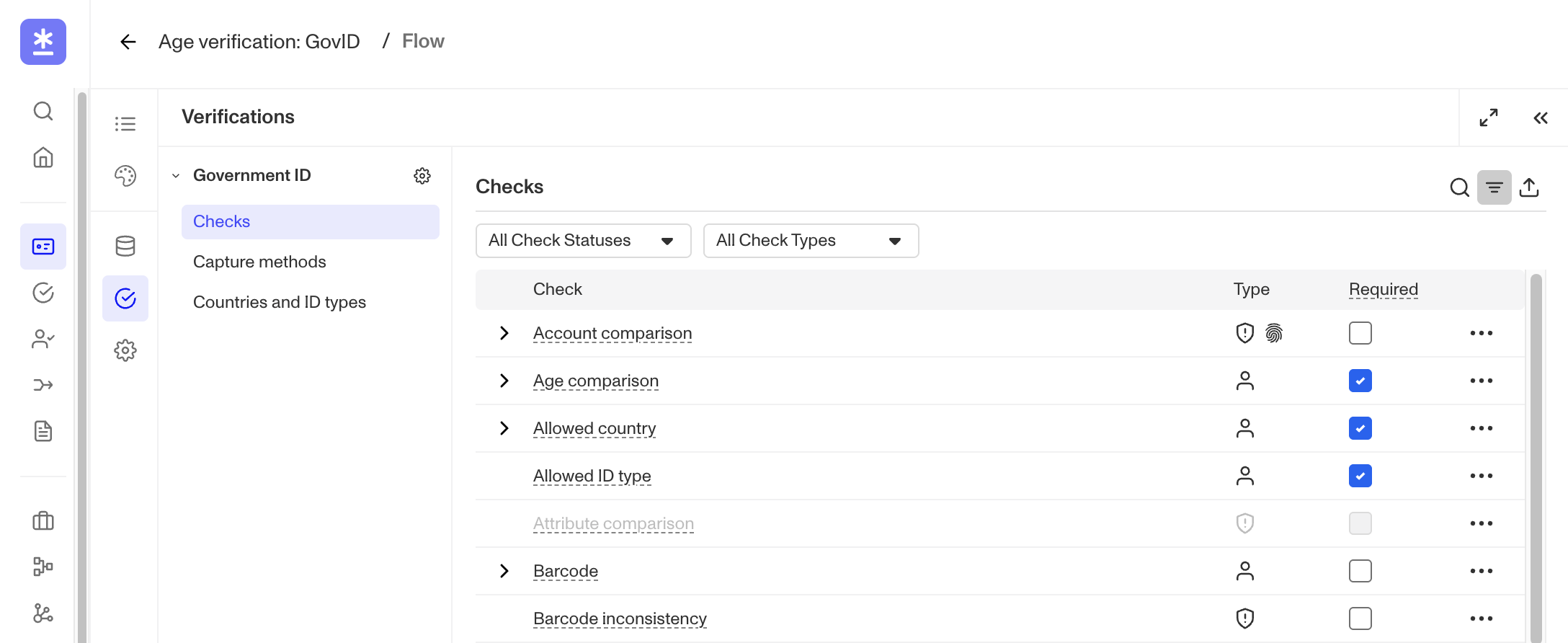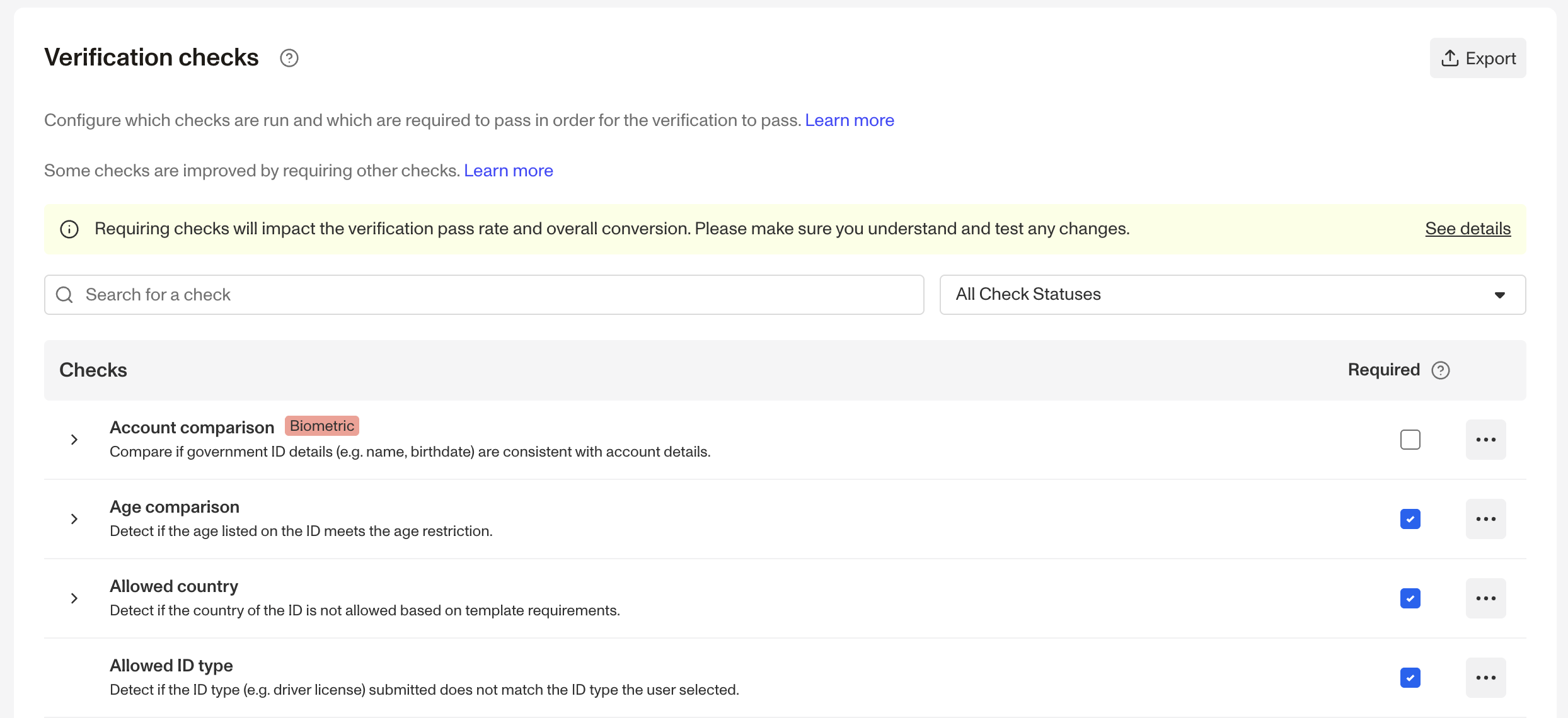Overview
Below, we'll guide you through choosing and configuring Verification checks for Government ID Verifications. We'll walk through each of these steps:
- Review possible Verification checks
- Choose which Verification checks to require
- Edit required checks
- Configure Enabled countries and ID types
Each step is important. The first two steps will help you decide what you want. The last two steps walk through how to configure the changes.
Prerequisites
- The ability to configure Verification checks is available on paid plans. If you're on the free plan and want to upgrade, please contact us here.
- If your Verification check configurations are fully managed by your Persona team, you will not be able to edit them yourself. Please reach out to your customer success manager if you would like to make changes.
Background
- Government ID Verification is one of the many types of Verification Persona offers.
- For each type of Verification comes with a suite of Verification checks for that type. These checks validate what an end user submits.
- If any required check fails, the Inquiry fails. You can pick which checks you want to require by following these steps.
Step 1: Review possible Verification checks
- Visit the Verification checks reference in the Dashboard. Find the section for Government ID checks.

- The table includes all possible checks to choose from. For example, checks include:
- Barcode: require the presence of a barcode on the ID
- Expiration: require that the ID is not expired
- Allowed ID type: require the type of ID to be one of the types you allow
- Some checks compare what a user submits against other data. To learn more, see: Government ID Verification checks that compare Inquiry and Account data
Step 2: Choose which Verification checks to require
- Consider the business goals of the Inquiry Template. Consider the problem that this Inquiry Template solves. What's the most important goal?
- E.g. Do you want to prioritize avoiding false positives (people passing verification who should not), or avoiding false negatives (people failing verification who should not)?
- The more strict your verification needs are, the more checks you may want to require.
- Some checks are more fraud oriented while others are more conversion oriented. Use the Verification check reference to see which checks are more suitable for your business.
- Get started and iterate. Keep in mind that you can adjust Verification checks as your needs change. For example, you can start with the defaults, then change one check to see how it impacts your Inquiry pass rates. You can use Inquiry Analytics to help you decide if it was an improvement.
Step 3: Edit required checks
- Once you decide which Verification checks to require, you can add or remove a required Verification.
- For Government ID Verification Templates within an Inquiry Template:
- In the Persona Dashboard, navigate to Inquiries > Templates. Select a template that uses Government ID Verification.
- Once you are in the Flow Editor, use the Left Panel to head to Verifications.
- Select the Government ID Verification template.
- Navigate to Checks.

- For Government ID Verification Templates used alongside a Transaction, Workflow, or via API:
- For Government ID Verification Templates used alongside a Transaction, Workflow, or via API
- In the Persona Dashboard, navigate to Verifications > Templates.
- Select the desired Government ID Verification Template that you'd like to change.

Step 4: Configure Enabled countries and ID types
This step is important — these settings are sometimes required for your Verification checks to work. Here are settings unique to Government IDs:
- ID type
- Government IDs come in a few flavors. The main types are:
- Driver's license
- Passport
- National ID
- You can choose which type(s) to accept. Consider what ID types your users will likely have, and have easy access to.
- Government IDs come in a few flavors. The main types are:
- Front side, back side
- IDs have a front side, and a back side. Back sides often contain a barcode.
- You can choose to require the front and/or back side.
- If the back side has a barcode, collecting the back side can help with extracting information from the ID.
- In some countries, you must collect the back side in order to extract information from the ID. See the international coverage map for details.
- See the international coverage map to see if a country you want to support requires you to collect the back side.
